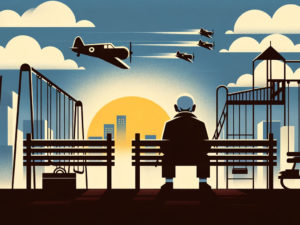“Closing Time” is a novel by Joseph Heller, published in 1994. It serves as a sequel to his acclaimed work “Catch-22,” revisiting some of the characters from the original book, notably Yossarian, during their later years in New York City. Let’s summarise “Closing Time”, dive into interesting facts about it and answer a frequently asked questions.
Short Recap of The Plot
 In “Closing Time,” Joseph Heller revisits the protagonist of “Catch-22,” Yossarian, now an aging man living in New York City. The novel intertwines Yossarian’s narrative with those of his wartime companions, who are also grappling with the challenges of old age, illness, and the prospect of death.
In “Closing Time,” Joseph Heller revisits the protagonist of “Catch-22,” Yossarian, now an aging man living in New York City. The novel intertwines Yossarian’s narrative with those of his wartime companions, who are also grappling with the challenges of old age, illness, and the prospect of death.
Yossarian, once a rebellious bombardier, is now a retired corporate executive faced with the absurdities of modern life and the healthcare system. His friend Milo Minderbinder has become a wealthy but morally ambiguous businessman, while Chaplain Tappman struggles with his faith and purpose.
The plot unfolds against the backdrop of a surreal, bureaucratic afterlife, where characters such as Sammy Singer and Lew Rabinowitz find themselves in an exclusive bar that serves as a purgatory for the deceased. Heller uses this setting to explore themes of mortality and the afterlife, employing his trademark satirical humor.
As the characters confront their past and present, the novel also touches on historical events, including the Cuban Missile Crisis and the Cold War, reflecting on the impact these have had on American society.
“Closing Time” culminates in a fantastical, apocalyptic finale, merging the real with the absurd in a way that only Heller could orchestrate. The novel is a darkly comedic meditation on the end of life, the follies of humanity, and the inescapable nature of death.
Interesting Facts About “Closing Time”
- Sequel to “Catch-22”: “Closing Time” revisits the iconic characters of Heller’s seminal work, exploring their lives in the twilight of their years.
- Yossarian Returns: The novel catches up with Yossarian decades after the events of “Catch-22,” providing a unique perspective on the character as he faces old age.
- Critique of American Life: Heller offers a scathing critique of late 20th-century American capitalism, healthcare, and politics.
- Apocalyptic Vision: The novel includes a darkly comedic and apocalyptic finale that aligns with Heller’s signature blend of the surreal and the serious.
- Mixed Reception: Unlike the critical success of “Catch-22,” “Closing Time” received mixed reviews, with some readers and critics finding it lacking compared to its predecessor.
- Reflections on Mortality: Through its aging characters, the book delves into themes of mortality, the meaning of life, and the search for closure.
- Cold War Paranoia: Heller incorporates the tension and paranoia of the Cold War into the narrative, reflecting on how the fear of nuclear annihilation permeated American consciousness.
- Afterlife Imagery: The novel features imaginative depictions of the afterlife, drawing on the absurdity and bureaucracy that were hallmarks of “Catch-22.”
- Heller’s Later Work: “Closing Time” is one of Heller’s later novels, and it showcases his development as a writer who continued to address serious themes with humor and irony.
- Real-world Events: Real historical events are woven into the story, grounding the characters’ experiences in actual American history.
Frequently Asked Questions About “Closing Time”
How does “Closing Time” connect to “Catch-22”?
“Catch-22” centered on the absurdities of war, while “Closing Time” confronts the absurdities of aging and the end of life. Characters from “Catch-22” reappear, providing a sense of continuity and closure to their stories.
Does “Closing Time” have the same satirical bite as “Catch-22”?
While “Closing Time” retains elements of Heller’s satire, its tone is often more reflective and somber, focusing on the personal struggles of the characters with aging and mortality rather than the broader farce of war.
Is “Closing Time” a comedy or a tragedy?
The novel blends elements of both, with comedic moments reflecting on the ironies of life, and tragic elements that arise from the characters’ confrontations with death and the passage of time.
What is the significance of the novel’s title, “Closing Time”?
The title reflects the end-of-life themes and the notion of “last call” for the characters, symbolizing the closing chapters of their lives and the winding down of their personal stories.
Do you need to read “Catch-22” before “Closing Time”?
While “Closing Time” can stand on its own, reading “Catch-22” first provides a richer understanding of the characters and themes that Heller revisits and expands upon in the sequel.
Share Your Verdict!
👴✈️ Is “Closing Time” a worthy last call for our beloved “Catch-22” crew, or has Heller’s sequel crashed and burned? 💥📚
🗣️ Sound off in the comments! Is this the poignant finale we craved, or a literary letdown we never needed? Tell us if Heller is hitting the mark or missing by a mile! 🎯👎

Comments